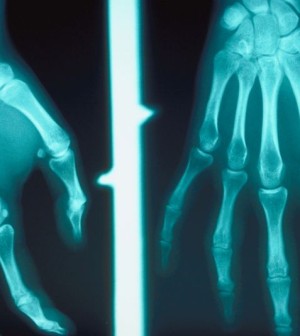- Tips for Spending Holiday Time With Family Members Who Live with Dementia
- Tainted Cucumbers Now Linked to 100 Salmonella Cases in 23 States
- Check Your Pantry, Lay’s Classic Potato Chips Recalled Due to Milk Allergy Risk
- Norovirus Sickens Hundreds on Three Cruise Ships: CDC
- Not Just Blabber: What Baby’s First Vocalizations and Coos Can Tell Us
- What’s the Link Between Memory Problems and Sexism?
- Supreme Court to Decide on South Carolina’s Bid to Cut Funding for Planned Parenthood
- Antibiotics Do Not Increase Risks for Cognitive Decline, Dementia in Older Adults, New Data Says
- A New Way to Treat Sjögren’s Disease? Researchers Are Hopeful
- Some Abortion Pill Users Surprised By Pain, Study Says
Common Shoulder Injury Heals Well Without Surgery: Study

A common shoulder injury that is usually repaired with surgery can heal just as well with nonsurgical treatment, a new study suggests.
And, the researchers added, those who decide against surgery for a dislocated shoulder joint develop fewer complications and get back to work sooner. But, surgery patients seem more satisfied with the appearance of their shoulder after treatment.
Found at the top of the shoulder between the collarbone and the shoulder blade, the acromioclavicular (AC) joint is often injured during sports. It can also be dislocated in a fall or car accident. People with a minor injury can wear a sling and undergo physical therapy. More severe dislocations are often treated with surgery involving a plate and screws, according to the researchers.
“For severe AC joint dislocations, surgery is the common practice but there’s not much evidence to suggest this is actually the best treatment,” study author Dr. Michael McKee said in a news release from St. Michael’s Hospital in Toronto, where he is an orthopedic surgeon.
In order to investigate this issue further, the study’s authors assigned 83 people with moderate to severe AC joint dislocations to either undergo surgery and rehabilitation or receive nonsurgical treatment with a sling and rehab.
The participants were followed for two years. The researchers kept track of their complications, level of disability and satisfaction with their shoulder’s appearance.
The study, published Oct. 22 in the Journal of Orthopaedic Trauma, found that patients treated without surgery could move their shoulders better than those who had surgery at follow-up sessions six weeks and three months after their injury.
After six months, researchers found no major differences between the two groups.
“Three months after the initial injury, more than 75 percent of the patients who did not have AC joint surgical repair were able to return to work, whereas only 43 percent of those who underwent surgery were back at work,” McKee said.
Of 40 patients who had surgery, seven developed major complications such as a loose plate or a deep wound infection. Seven others, meanwhile, experienced minor infection, numbness at the point of the incision or another minor complication.
In contrast, of the 43 patients treated with a sling and rehabilitation, only two had major complications, the study found. Both were the result of a repeat injury.
Surgical patients, however, were more satisfied with the appearance of their shoulder after treatment. Only 5 percent of the surgical patients were unhappy with their appearance a year after treatment, compared to 16 percent of nonsurgical patients. After two years, the difference was even greater, with 21 percent of nonsurgical patients dissatisfied compared to 4 percent of those who had surgery.
“The main advantages of surgery are that the joint is put back in place and the shoulder appears more symmetrical and pleasing to the eye. The long-term implications of surgery for AC joint dislocation remain unclear when compared to nonoperative treatment,” McKee said.
While appearance is a consideration, McKee said doctors should “think twice” before recommending surgery for an AC joint dislocation, no matter how severe. “Patients who forgo surgery return to work sooner, experience less disability during the first months after injury and have fewer complications,” he concluded.
More information
The American Academy of Orthopaedic Surgeons provides more information on shoulder dislocation.
Source: HealthDay
Copyright © 2024 HealthDay. All rights reserved.










